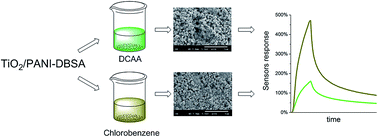The PANI-DBSA content and dispersing solvent as influencing parameters in sensing performances of TiO2/PANI-DBSA hybrid nanocomposites to ammonia†
Abstract
We demonstrate here strong influences of the content of polyaniline (PANI) doped with dodecylbenzenesulfonic acid (DBSA) and the nature of dispersing solvents chlorobenzene (CB) and dichloroacetic acid (DCAA) on the morphology and sensing properties of TiO2/PANI-DBSA hybrid nanocomposite layers cast on transducer electrodes. The obtained results evidence that these effects are caused by the solubility of the PANI component of the synthesized nanocomposites in the solvents and the boiling temperature of the latter. To estimate a quantitative effect of PANI, we used the real contents of the PANI-DBSA component/phase determined from the PANI polymerization yield. The highest magnitudes and rates of the sensor responses to gaseous ammonia are shown by the nanocomposite layer with an intermediate PANI-DBSA content (18.9 wt%) and cast from the nanocomposite dispersion in CB. We explain this effect by the specific morphology of the layer, which appears to be due to the poor solubility of the PANI-DBSA component in this solvent. The comparison of sensitivity of the chemically synthesized nanocomposites to ammonia with that of their mechanically mixed analogs demonstrates the better sensing performance of the former.


 Please wait while we load your content...
Please wait while we load your content...